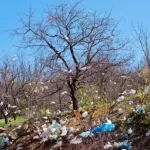The Once-In-An-Eon Event That Gave Earth Plants Has Happened Again
The post The Once-In-An-Eon Event That Gave Earth Plants Has Happened Again appeared first on Healthy Holistic Living.
In the boundless and often mysterious expanse of the natural world, every so often, an event so rare occurs that it reshapes our understanding of life itself. Such events, which have transpired only a handful of times throughout Earth’s long history, involve the birth of entirely new organelles within living cells—complex structures that are critical for life. These organelles, from mitochondria to chloroplasts, have not only been pivotal in the evolution of complex life forms but also continue to play essential roles in the biological processes that sustain our planet.
Recently, scientists have documented a phenomenon akin to these monumental events, marking only the fourth known instance in the annals of natural history. This discovery revolves around the integration of a nitrogen-fixing bacterium into its algal host, resulting in the creation of a new organelle. Dubbed the “nitroplast,” this development represents a significant leap in our understanding of cellular evolution and highlights the innovative ways nature sustains life on Earth.
As we delve into this remarkable discovery, let us keep our curiosity alight and our minds open to the lessons it offers, not just about the natural world, but also about the potential for future innovations that might one day spring from understanding such profound natural phenomena.
The Discovery of the Nitroplast
The scientific community has recently been abuzz with the confirmation of the first nitrogen-fixing organelle within a eukaryotic cell, named the “nitroplast.” This groundbreaking discovery is the result of decades-long research that began with the detection of a mysterious DNA sequence in the Pacific Ocean by Jonathan Zehr, a professor at UC Santa Cruz. This sequence was later identified as belonging to a then-unknown nitrogen-fixing cyanobacterium, UCYN-A.
Further research revealed that UCYN-A had developed a symbiotic relationship with a marine alga, which was meticulously cultured over many years by Kyoko Hagino at Kochi University. This algae, known as Braarudosphaera bigelowii, became the host for UCYN-A, which has now evolved into an integral part of the algal cell, thus forming the nitroplast.
The development of the nitroplast is a notable example of primary endosymbiosis, where a symbiotic bacterium evolves to become an organelle within its host cell. This process has been observed only three other times throughout Earth’s history: the evolution of mitochondria, chloroplasts, and a chloroplast-like structure in an amoeba. Each of these instances marked significant evolutionary milestones, suggesting the potential importance of the nitroplast in understanding cellular and ecological processes.
The nitroplast’s ability to fix nitrogen—a process crucial for converting atmospheric nitrogen into forms usable by living organisms—parallels the transformative impact of the mitochondria and chloroplasts on life on Earth. Researchers have observed that UCYN-A and its host algae share a synchronized nutrient exchange, indicating an evolved dependency similar to that seen in other organelles. This relationship not only underscores the organelle’s functionality but also its evolutionary significance.
Advanced proteomic analyses have shown that the nitroplast imports proteins from the host alga, which are essential for filling functional gaps within UCYN-A. This interdependence highlights the intricate relationships and mechanisms that govern organelle evolution.
The implications of this discovery extend beyond academia. Understanding the nitroplast’s role in natural nitrogen fixation could revolutionize agricultural practices, potentially reducing reliance on industrial processes like the Haber-Bosch method, which are significant sources of global carbon emissions. Researchers are optimistic that insights gleaned from studying the nitroplast could lead to the development of sustainable agricultural technologies, fostering a new era of eco-friendly farming.
This discovery not only challenges our understanding of cellular biology but also opens new avenues for environmental and agricultural innovations. As we continue to explore the capabilities and impacts of the nitroplast, it may well become a cornerstone of biology textbooks and sustainability strategies in the future.
Understanding Nitrogen Fixation
Nitrogen fixation is a pivotal biological process where nitrogen (N₂) from the atmosphere is converted into a form that organisms can utilize, such as ammonia (NH₃). This conversion is essential because most life on Earth cannot directly use atmospheric nitrogen, even though it comprises about 78% of the air we breathe. Instead, life forms need nitrogen in a “fixed” form to synthesize essential compounds like proteins and nucleic acids.
The Biological Process
Nitrogen fixation is primarily performed by certain bacteria and archaea, known as diazotrophs. These microorganisms can be free-living in soil or water, or they can form symbiotic relationships with plant roots, particularly legumes. In these symbiotic relationships, the bacteria fix nitrogen in exchange for carbon and energy sources from the plant.
In marine environments, nitrogen fixation is carried out by microorganisms in the upper layers of the ocean. This process contributes significantly to the nitrogen available in marine ecosystems, supporting a wide range of biological functions.
Ecological and Agricultural Significance
Nitrogen fixation is crucial for maintaining the fertility of the soil by replenishing nitrogen that is used up by plants. This natural process limits the need for synthetic fertilizers, which can have adverse environmental impacts, such as contributing to greenhouse gas emissions and causing water pollution through runoff.
The discovery of the nitroplast, a new organelle in marine algae that can fix nitrogen, represents a significant advancement in our understanding of nitrogen fixation. This discovery could have profound implications for sustainably improving agricultural productivity by reducing dependency on chemical fertilizers and enhancing the natural nitrogen-fixing abilities of crops.
Benefits of Nitrogen Fixation
Nitrogen fixation is a natural process with far-reaching benefits that might seem almost magical, yet it’s grounded in the science of ecology and agriculture. Here’s how this remarkable process supports life and sustains our planet:
Nourishing the Ecosystem: Nitrogen is a fundamental building block of life, essential for the creation of amino acids, proteins, and DNA. Despite its abundance in the atmosphere, most living organisms cannot use nitrogen in its gaseous form. Nitrogen fixation converts this inert gas into ammonia or related compounds, which plants and other organisms can readily absorb and use. This conversion is crucial for the growth and health of all plant life, supporting diverse ecosystems from lush rainforests to vibrant coral reefs.
Boosting Agricultural Productivity: For agriculture, the ability to fix nitrogen is a game-changer. Crops depend heavily on nitrogen for growth, and the natural process of nitrogen fixation can reduce the need for synthetic fertilizers, which are costly and environmentally damaging. Legumes, such as peas, beans, and lentils, are well-known for their ability to fix nitrogen, thanks to symbiotic bacteria in their root nodules. This not only enhances soil fertility but also promotes sustainable farming practices by naturally replenishing soil nutrients.
Mitigating Climate Change: Nitrogen-fixing plants can play a role in climate mitigation. By reducing the reliance on synthetic nitrogen fertilizers, which require high energy inputs and produce significant greenhouse gases, nitrogen fixation can help lower agricultural carbon footprints. Moreover, healthier soils rich in organic matter can store more carbon, further aiding in carbon sequestration efforts.
Supporting Biodiversity: Nitrogen-fixing plants contribute to biodiversity in ecosystems. These plants can thrive in nutrient-poor soils where other plants might fail, thus providing a foundation for other species to colonize and diversify. For instance, after disturbances such as volcanic eruptions or landslides, nitrogen-fixing plants often lead the natural reclamation process, paving the way for ecosystems to rebuild and flourish.
Pioneering Green Technologies: The study of natural nitrogen fixation processes also inspires technological innovations aimed at creating more sustainable agricultural methods. Scientists are exploring ways to engineer non-leguminous crops with nitrogen-fixing abilities, which could revolutionize farming practices worldwide by reducing dependency on chemical fertilizers and enhancing crop resilience to environmental stresses.
Historical Context and Previous Occurrences
The evolution of organelles like mitochondria and chloroplasts represents critical milestones in the history of life on Earth. These organelles originated from a process known as endosymbiosis, where one cell engulfed another, and instead of digesting it, the two cells formed a symbiotic relationship that proved beneficial for both.
Mitochondria
Mitochondria, often referred to as the powerhouses of the cell, are believed to have originated from an aerobic prokaryote that was engulfed by an early eukaryotic cell. This event likely occurred only once, as evidenced by the conserved set of genes found in the mitochondrial DNA across all known eukaryotic groups. This single origin of mitochondria has reshaped our understanding of eukaryotic evolution, suggesting that endosymbiosis played a central role in the development of complex cells.
Chloroplasts
Similarly, chloroplasts, which are crucial for photosynthesis in plants and algae, are thought to have evolved from photosynthetic prokaryotes, specifically cyanobacteria, that were engulfed by a eukaryotic host. This incorporation not only allowed the host cell to produce its own food via photosynthesis but also significantly contributed to the oxygenation of Earth’s atmosphere, thereby altering the planet’s life support system.
Both mitochondria and chloroplasts have retained some of their original prokaryotic DNA, which has been integral in tracing their evolutionary paths and understanding their functions within eukaryotic cells. The development of these organelles not only facilitated the evolution of complex life forms but also illustrates the profound impact of symbiotic relationships in nature.
This historical perspective highlights the rarity and significance of such endosymbiotic events, similar to the recent discovery of the nitroplast, and underscores the transformative nature of these evolutionary milestones in the broader context of life on Earth.
Implications for Environmental Sustainability
The discovery of the nitroplast, a novel organelle capable of fixing nitrogen, holds transformative potential for environmental sustainability and agricultural practices. This breakthrough offers a new understanding of how nitrogen fixation can be integrated into eukaryotic cells, potentially reducing the environmental footprint of agricultural fertilization.
Enhancing Ocean Ecosystems
Nitrogen is a critical nutrient in marine ecosystems, limiting the growth of phytoplankton, which forms the base of the oceanic food chain. By facilitating natural nitrogen fixation, organisms containing nitroplasts could enhance the productivity and carbon cycling within these ecosystems, which is vital for maintaining biodiversity and ocean health.
Revolutionizing Sustainable Agriculture
Currently, the Haber-Bosch process dominates industrial nitrogen fixation, producing ammonia from atmospheric nitrogen. While this process has been a cornerstone of modern agriculture, enabling high yields to support global food demands, it is also energy-intensive and a significant source of carbon dioxide emissions. The nitroplast introduces a potential biological alternative that could be engineered into crop plants, offering a sustainable way to boost crop productivity without the associated environmental costs.
Potential for Carbon Sequestration
In addition to enhancing nitrogen fixation, the integration of nitroplasts into crops could potentially improve the efficiency of photosynthesis and increase carbon sequestration. This dual benefit could help mitigate climate change by removing excess carbon dioxide from the atmosphere while simultaneously improving soil health and crop resilience to changing climate conditions.
Practical Tips for Supporting Sustainable Practices
In light of the groundbreaking discovery of the nitroplast and its implications for environmental sustainability and agriculture, individuals can engage in several practical actions to support sustainable practices. Here are some tips that everyone can consider to make a positive impact:
1. Support Marine Conservation Efforts
Advocate for Protected Areas: Support policies and initiatives that create and maintain marine protected areas to safeguard marine biodiversity, which can benefit from healthier, more balanced ecosystems potentially supported by organisms like those with nitroplasts.
Reduce Plastic Use: Minimize the use of single-use plastics, which contribute to ocean pollution, affecting marine life and ecosystem health.
2. Promote Sustainable Agriculture
Buy Organic and Local: Whenever possible, purchase organic and locally produced foods. These practices often use fewer synthetic chemicals and fertilizers, reducing the environmental impact.
Community-Supported Agriculture (CSA): Participate in a CSA to get your produce directly from farmers, ensuring you receive fresh, seasonally appropriate foods while supporting sustainable agricultural practices.
3. Engage with and Support Scientific Research
Donate to Science: Consider donating to organizations and institutions that fund scientific research on sustainable technologies and biological studies, like those leading to discoveries such as the nitroplast.
Stay Informed: Educate yourself about the latest scientific discoveries and their potential impacts on sustainability. Share this knowledge within your community to raise awareness.
4. Advocate for Green Policies
Support Policies Reducing Carbon Emissions: Engage in advocacy for policies that aim to reduce carbon emissions, promoting cleaner energy sources that contribute less to global warming.
Environmental Nonprofits: Volunteer for or donate to nonprofits that focus on environmental preservation, advocating for sustainable practices across different sectors.
5. Reduce, Reuse, Recycle
Practice the 3Rs: Make an effort to reduce waste, reuse resources, and recycle materials. This not only decreases the amount of waste in landfills but also reduces the demand for raw materials, conserving natural resources and reducing carbon footprints.
These tips not only help in making environmentally friendly choices but also contribute to a larger movement towards sustainability, influenced by innovative scientific advancements like the development of the nitroplast.
Embracing the Future of Sustainability
The discovery of the nitroplast represents more than just a scientific breakthrough; it symbolizes a beacon of hope and innovation in our ongoing quest for sustainability. This new organelle not only deepens our understanding of cellular evolution and symbiosis but also opens up exciting possibilities for the future of environmental conservation and agricultural practices.
As we stand at the crossroads of ecological challenges and technological advancements, the role of scientific research becomes increasingly crucial. The integration of discoveries like the nitroplast into practical applications could revolutionize the way we approach food production, energy consumption, and overall environmental stewardship.
For individuals and communities alike, there is a powerful opportunity to align everyday actions with the principles of sustainability. By supporting conservation efforts, advocating for green policies, and embracing sustainable agricultural practices, we can all contribute to a healthier planet.
Ultimately, the ongoing study and potential applications of the nitroplast remind us that nature often holds the keys to our most pressing challenges. By continuing to support and invest in scientific research, we ensure that we are not only prepared to meet the challenges of today but are also paving the way for a sustainable and thriving future.
The post The Once-In-An-Eon Event That Gave Earth Plants Has Happened Again appeared first on Healthy Holistic Living.












